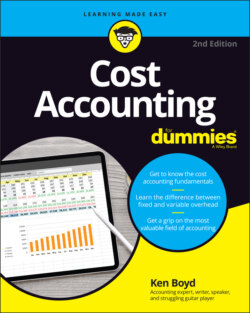Читать книгу Cost Accounting For Dummies - Kenneth W. Boyd - Страница 113
Walking through a manufacturing cost example
ОглавлениеSay you’re the manager of Karl’s Kustom Kitchen Kabinets. You order $20,000 in lumber. You then take $5,000 of the lumber and start making cabinets for a customer.
When you bought the lumber, cash (an asset) went down, but the material control account (as asset) went up. The material control account was increased (debited) when you bought the lumber.
The material control account balance decreases (credit) when you take $5,000 in lumber to start using the material for a customer. Now how would your material control account look?
Material control account
| Debit | Credit | |
|---|---|---|
| $20,000 | ||
| $5,000 |
If the month ends with no other activity, the ending material control balance is $15,000 (20,000 – $5,000).
But the $5,000 didn’t just vanish. When you put materials into production, you reduce (credit) the material control account and increase (debit) the work-in-process control account.
Work-in-process control account
| Debit | Credit |
|---|---|
| $5,000 |
You reduce one asset (material control account) and increase another asset (work-in-process control account).
Now assume that the people on the shop floor finish some cabinets and move $2,000 of the $5,000 work-in-process to finished goods.
Work-in-process control account
| Debit | Credit |
|---|---|
| $5,000 | |
| $2,000 |
You reduce one asset (work-in-process control account) and increase another asset (finished good control account). If the month ends with no other activity, the ending balance is $3,000 ($5,000 – $2,000).
Again, there’s no disappearing money. The “other side” of the transaction hits the finished goods control account.
Finished goods control account
| Debit | Credit |
|---|---|
| $2,000 |
So one more time, you reduce one asset (work-in-process control account) and increase another asset (finished goods control account).
At some point, you sell what you made. You’ve got $2,000 in finished goods. Because you make custom cabinets, there’s one customer. The finished goods control account shows this:
Finished Goods
| Debit | Credit |
|---|---|
| $2,000 | |
| $2,000 |
You are almost home. When goods are sold, you reduce (credit) the finished goods account and increase (debit) cost of goods sold. And that’s an expense account. At last!
Cost of Goods Sold
| Debit | Credit |
|---|---|
| $2,000 |
The difference between your sale price and the cost of goods sold is your profit.
Why do you go with the flow? The reason you do this exercise is to fully track where your inventory money is. For custom cabinets, it can be a big deal, if you’re building for, say, 20 customers at once. For off-the-shelf cabinets, it can be a very big deal. You might be delivering 2,000 cabinets per month.
The flow not only lets you see where the inventory money is, but also spot production logjams. Too much in the material control account suggest that you’re overbuying or not producing. Too much in the work-in-process control account suggests that you’re not producing. Too much in the finished goods control account suggests that you’re not selling and you have “dead inventory.”
